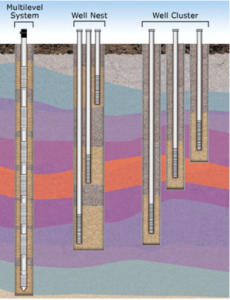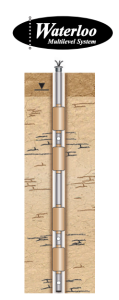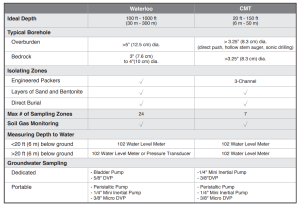The multilevel system essentially combines 3 to 7 monitoring wells into the one. This system has many pros: Firstly, it is a lot cheaper than drilling and installing multiple bores; and secondly, it allows for samples and standing water levels to be taken from multiple aquifers, allowing greater knowledge on the geology and interaction between groundwater and surface water.
The diagram below shows how the multiple screened intervals feed into separate tubes.


Solinst manufacture two different types of multilevel systems:
The Waterloo Multilevel System

The Waterloo possesses a modular structure that offers exceptional adaptability for various sites and applications. This flexibility permits the arrangement of ports and packers according to the requirements of borehole logs. The specially designed seals, along with dedicated sampling and level monitoring functionalities, have been effectively employed at depths of up to 1000 feet (300 meters). These systems are perfectly suited for extended monitoring in both bedrock and cased boreholes.

The CMT Multilevel System provides on-site design adaptability, cost-effectiveness, and simple installation. The quantity of monitoring ports, their placements, installation depths, and monitoring approaches can all be conveniently adjusted and planned directly in the field. The use of a single tube ensures efficient sealing. The 7-channel system measures 1.7″ (43 mm) and the 3-channel system measures 1.1″ (28 mm). These systems are well-suited for shallow applications in narrow diameter boreholes.
The table below highlights the differences between the two options:

If you are interested in learning about multilevel wells, here’s a great webinar by Richard Campbell from the HydroTerra Webinar Series:
Multilevels for characterisation of groundwater contamination





